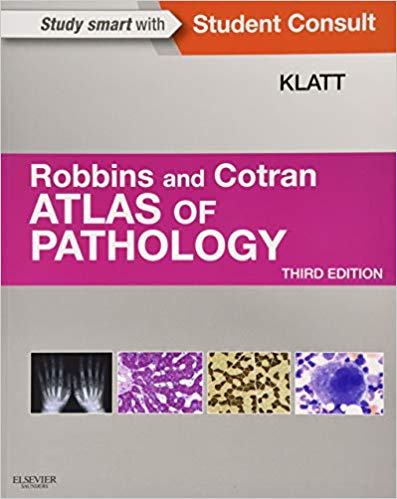Robbins and Cotran Atlas of Pathology (2015) contains more than 1,500 high-yield medical images, including clinical and intraoperative photographs, pictures of gross pathology specimens, blood smears, H&E stains, electron micrographs, funduscopic and endoscopic images, plain radiographs, CTs, ultrasonographic images, MRIs, and more. (I reviewed the previous edition of this book elsewhere. This review has been updated to reflect my perspective on the current edition).

The pictures are generally quite clear and clinically relevant, and are accompanied by authoritative captioning.
The chapter on kidney diseases is particularly very well done. You can tell that the author spent a lot of time, perhaps a lifetime, educating medical students. Take for example minimal change disease. An electron micrograph of the kidney is shown, and the caption reads:
On light microscopy the glomerulus is normal with minimal change disease (MCD), the most common cause of nephrotic syndrome in children. In this electron micrograph … normal fenestrated endothelium is present, and the basement membranes are normal in thickness with no immune deposits. Overlying epithelial cell (podocyte) foot processes are effaced (giving the appearance of fusion) and run together, which leads to loss of the normal anionic charge barrier such that albumin selectively leaks out, and proteinuria ensues, often with nephrotic syndrome. Most patients recover completely after a course of corticosteroid therapy.
Atlas of Pathology, page 273 (2015)
Just to show you how incredibly good this material is, I will unpack the above caption line-by-line and explain what the author meant to highlight with each phrase:
- Why the disease is called minimal change disease: “On light microscopy the glomerulus is normal”
- Epidemiology: “most common cause of nephrotic syndrome in children”
- Relevant histopathology: “Overlying epithelial cell (podocyte) foot processes are effaced”
- How to distinguish minimal change disease from diabetic nephropathy, transplant glomerulopathy and preeclampsia: “normal fenestrated endothelium is present [in minimal change disease]”
- How to distinguish minimal change disease from membranoproliferative glomerulonephritis: “the basement membranes are normal in thickness [in minimal change disease]”
- How to distinguish minimal change disease from postinfectious glomerulonephritis: “no immune deposits [in minimal change disease]”
- Pathophysiological consequences: “loss of the normal anionic charge barrier such that albumin selectively leaks out”
- Clinical consequence: “proteinuria ensues, often with nephrotic syndrome”
- Treatment and prognosis: “Most patients recover completely after a course of corticosteroid therapy.”
There really isn’t anywhere in medical writing where you can find more valuable and high yield information packed into such short paragraphs!
New to this edition is a free online ebook to go along with the hard copy. It is fully searchable, and allows you to see the slides in greater clarity and higher resolution.
This book remains one of the best medical books of all time and one of the best basic sciences books for medical students. I recommend it very highly to medical students and to anyone who is otherwise interested in pathology.


Leave a Reply